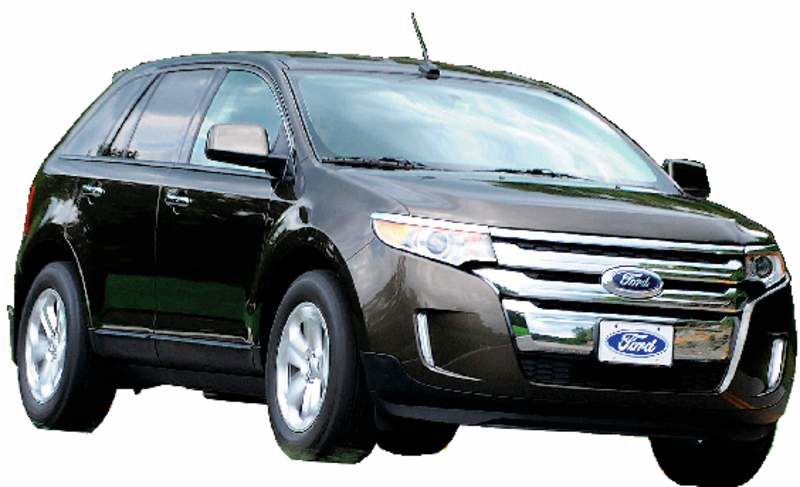Ford Edge: living proof of a better idea
Published 5:00 am Sunday, May 8, 2011

- The 2011 Ford Edge crossover-utility vehicle is competitive with other vehicles in its class.
NEW YORK — Magic had nothing to do with it. Virtue — represented in popular thinking by Ford Motor Co.’s refusal to join its Detroit brethren in begging for federal bailout loans in 2008 — had nothing to do with it, either.
Truth is, in 2008, Ford couldn’t afford to borrow another penny. It had already borrowed so much money, its famed blue-oval logo was in hock.
It is what Ford did with commercial loans that led to its recently reported first-quarter profit of $2.6 billion, its highest reported quarterly earnings since 1998.
Ford, under the guidance of Alan Mulally, who became chairman and chief executive in 2006, poured most of that money into products.
That means the company stopped wasting money, time and effort in a futile attempt to support its fancy, high-maintenance, low-to-no-profit corporate mistresses — Aston Martin, Jaguar and Land Rover, all of which were sold to fund improvements in Ford’s core products, including the 2011 Ford Edge crossover-utility vehicle, which is this week’s review subject.
The Mulally era represented a new kind of thinking at Ford. Product quality was no longer a jingoistic “Job One”; it was the only way Ford could survive. Fuel economy was no longer a marketing scam to lull federal regulators to sleep; it was Ford’s future and the future of the global automobile industry.
The results of the Mulally era were on display last month at the New York International Auto Show, where Ford once featured mostly SUVs and pickup trucks.
The big rides were still there, along with the usual high-performance suspects — the Shelby Cobra and Mustang sports cars. But the Ford display attracting the most attention was the company’s “Four in the Forties” group: four snazzy cars that reportedly get 40 miles per gallon or better on the highway.
The four are the subcompact Ford Fiesta SE with SFE (super fuel economy), the Ford Fusion Hybrid sedan, the compact Ford Focus sedan and the Lincoln MKZ Hybrid sedan. Ford promises more fuel-efficient cars, and trucks, to come.
One member of Ford’s light-truck family, the 2011 Ford Edge, is a case in point. It was in the works at least a couple of years before Mulally’s arrival and was introduced when he moved to Ford in 2006.
There was little edgy about that first Edge. It was likable but generally underwhelming. The interior was full of cheap-feel materials.
The six-cylinder engine was both underpowered and unremarkable in its fuel efficiency — barely 23 miles per gallon on the highway in real-world travel.
The aggressively reworked 2011 Edge Limited, driven here and in Upstate New York, was discernibly superior in all areas — exterior styling, quality of interior materials, handling and acceleration, the latter thanks to a much-improved 3.5-liter V-6 engine (285 horsepower, 253 foot-pounds of torque).
That’s 20 more horsepower than the predecessor Edge V-6. Yet, by my records, the new Edge V-6 delivers four miles per gallon better on the highway. Like the first Edge, it runs on regular gasoline.
Those are relatively small things, but “small” in the way that small things often lead to big developments, such as $2.6 billion in quarterly profits.
None of this is to suggest that Ford has completely climbed out of the economic quagmire in which it found itself several years before Mulally’s arrival.
There are challenges aplenty, including rapidly rising raw-materials prices and the cost of an ambitious expansion project in China.
But Ford’s fiscal results, thus far, do speak to the simple rightness of Mulally’s basic approach. It has nothing to do with magic, nothing to do with virtuous self-righteousness. It has everything to do with what it has always had to do with in the automobile industry: product.
Bottom line
It’s finally competitive with other vehicles in its class, such as the Nissan Murano. But even CEO Alan Mulally knows that “competitive” does not necessarily mean better. He has to keep working.
Ride, acceleration and handling: The Edge gets “very good” marks in all three.
Head-turning quotient: Exterior styling — muscular, borderline sexy — is attractive. Interior styling and material quality are excellent.
Capacities: Seats for five people. Cargo capacity is 32.2 cubic feet with all seats up and 68.9 cubic feet with rear seats down. The Edge Limited can be equipped to tow a trailer weighing 3,500 pounds. Fuel capacity is 18 gallons. Regular unleaded is OK.
Safety: Standard equipment includes front and rear ventilated disc brakes, four-wheel anti-lock protection, electronic brake-force distribution, electronic stability and traction control, and side and head air bags.
Optional equipment recommended by this column includes blind-spot monitoring.
2011 Ford Edge
Base price: $34,525
As tested: $46,095, including $3,795 in options (dual-panel glass roof, premium audio with satellite access, onboard navigation with backup camera and other items) and a $7,775 destination charge.
Type: Front-engine, front-wheel-drive midsize crossover-utility vehicle (think wagon) of unitized-body construction. It has four side doors and a rear liftgate.
Engine: The 3.5-liter, 24-valve V-6 engine (285 horsepower, 253 foot-pounds of torque) is linked to a six-speed transmission that can be operated automatically or manually.
Mileage: The Environmental Protection Agency says you get 19 miles per gallon in the city and 27 on the highway, which closely reflects my real-world experience.






